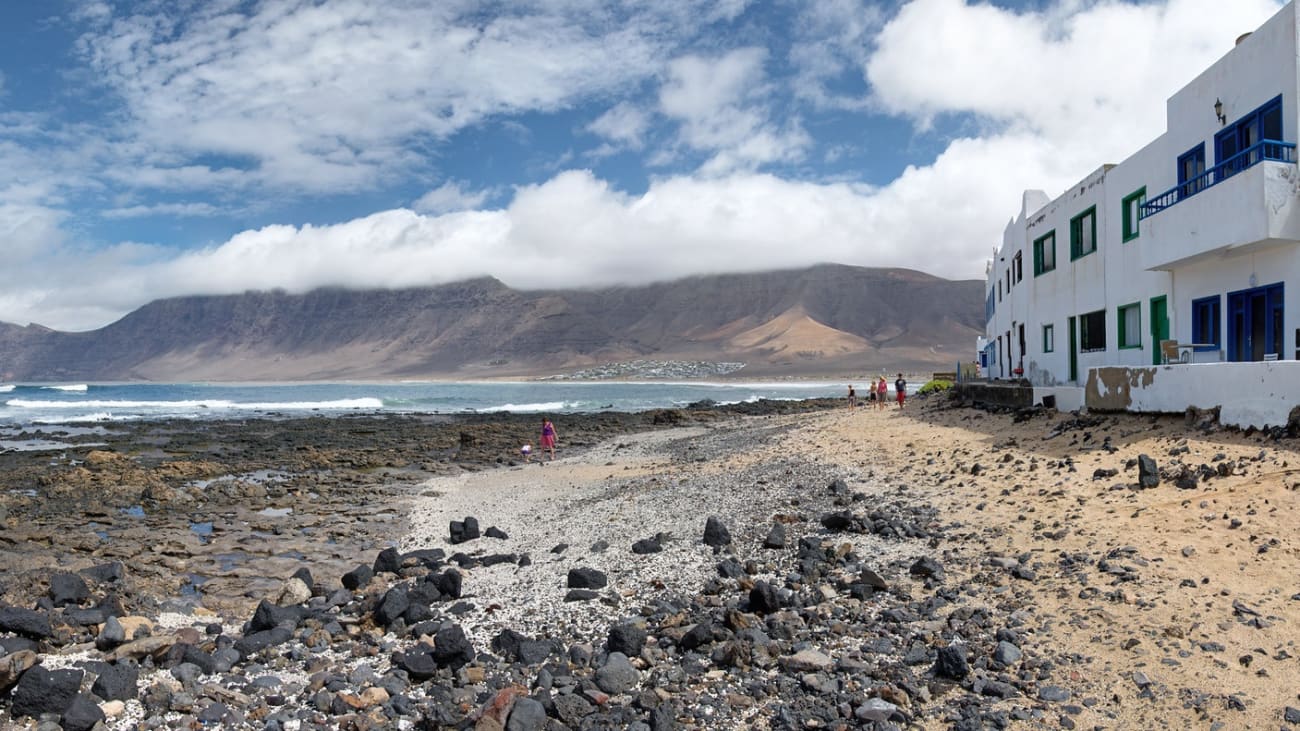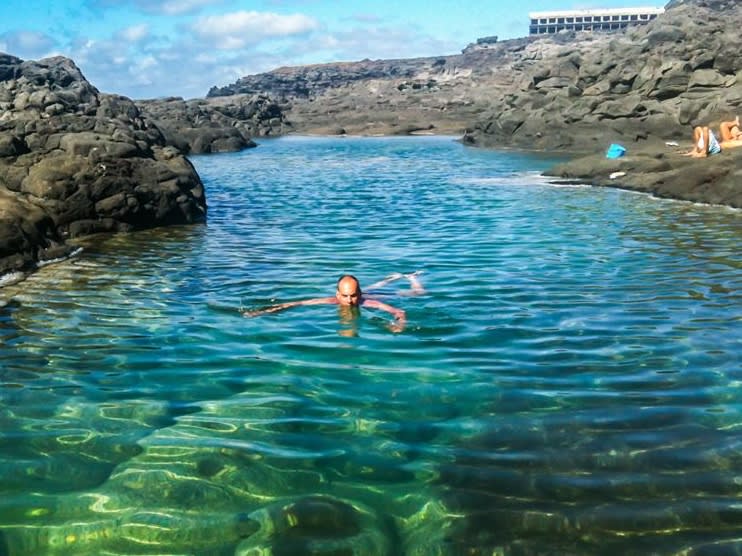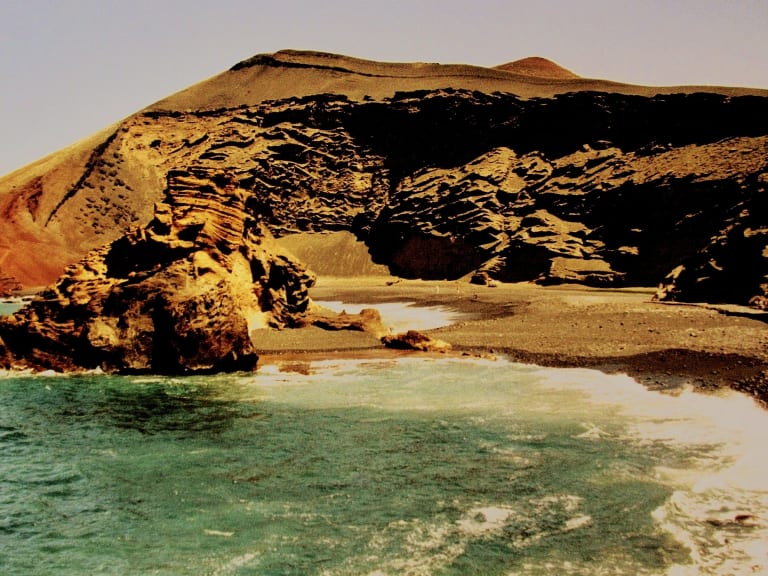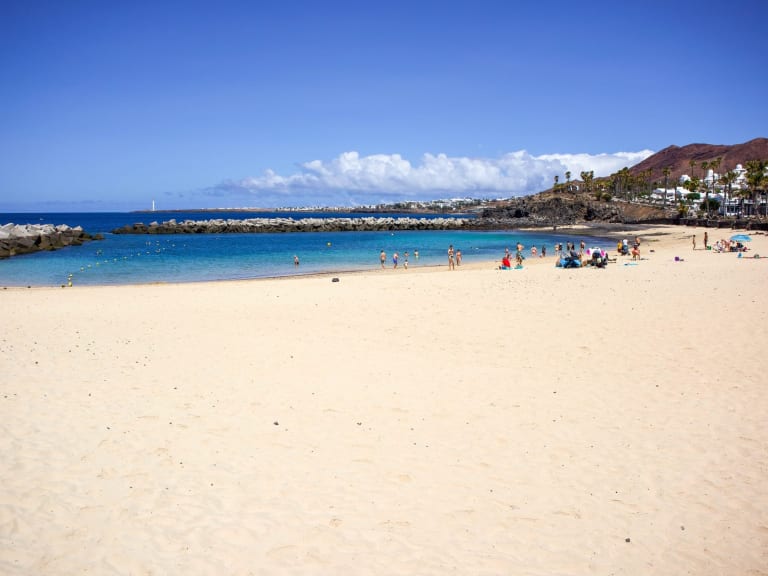The 10 Best Beaches in Lanzarote
Let yourself be fascinated by the coastline of Lanzarote, the easternmost island of the archipelago. Some of its beaches are among the best in the Canary Islands.

Lanzarote | ©Antonio Ortega
Thousands of tourists come to the Canary Islands for its unbeatable climate. As for the rest of the archipelago, Lanzarote also has few rainy days and pleasant temperatures from January to December.
As a result, the beaches are among the best attractions of Lanzarote. Its coastline alternates natural pools, black rocky shores, coves of fine sand and large shores with sun loungers and parasols. Read on and discover the 10 best beaches of Lanzarote.
1. Natural pools of Los Charcones

A few kilometers from Playa Blanca is a virgin coastline, abrupt and characterized by basaltic rocks overlooking the ocean. The area of the natural pools is on higher ground than the sea. Breaking on the rocks, the waves fill the cavities with turquoise water.
If you want a tip, it is not the most advisable destination if you travel to Lanzarote with small children. The access is a bit complicated: it is necessary to wear appropriate footwear - crab booties prevent falls and sprained ankles - as well as the classic sunscreen to avoid sunburns.
Practical information
- How to get there: from Playa Blanca, you just have to leave the center and walk along the avenue of the Pechiguera Lighthouse until the end. You will arrive near the ruins of a hotel; once there, you must go down the rocks towards the sea
- Where to eat: Los Charcones is located in an isolated spot and there are no options for eating near the coast. You can buy something to take away at the nearby Playa Blanca
- Recommended for those who want to swim in a natural landscape shaped by volcanic activity.
2. Papagayo Beaches

It is located east of the tourist center of Playa Blanca and consists of a few different coves. You can go from one to another through the dunes or walking along the coastline (when the tide is low). Here are the main ones:
- Playa Mujeres, the closest to the town center. It is characterized by white sand and low waves. It has a parking lot a short distance from the coastline
- El Pozo, also known as Playa de La Cruz. A short distance from the shore is the archaeological site of San Marcial del Rubicon. In fact, the first Castilian explorers settled here to hunt the seals of the island of Lobos
- Papagayo, sheltered by two black cliffs that isolate it from the trade winds. On the heights there are some small beach bars and a parking lot
- Caleta del Congrio, the privileged place for naturists
- La Cera, next to Papagayo Beach. During the summer it can be quite crowded
- Puerto Muelas, the favorite of camping lovers
Some of these stretches of coastline are difficult to access and it is preferable to visit them by hiring one of Lanzarote's boat trips, specifically by catamaran. In case you travel by land, I recommend you to wear comfortable shoes because you will have to walk on unpaved trails.
Practical information about Lanzarote
- How to get there: not all beaches have a parking lot but you can access through the Avenida de Papagayo. You will have to pay about 3 € to access
- Where to eat: apart from the beach bars of Playa Papagayo, there are few places to eat. In nearby Playa Blanca I recommend Simple y Natural (Centro Comercial El Pueblo) and La Casa Roja (Puerto Deportivo Marina Rubicón)
- Recommended for those who want to see a stretch of virgin coastline.
3. Charco de los Clicos

A spectacular beach on the west coast of Lanzarote. A few meters from the sea there is a lake of elongated shape and intense green color.
It is the crater of an ancient volcano and its color is due to the seaweed Ruppia maritima and abundant sulfur residues. If you are familiar with it, maybe it is because you have seen it in Pedro Almodovar's "Broken Embraces".
You can not bathe, but it is not a problem, you have the sea two steps away. Charco de los Clicos can be the last stage after a day in the nearby Natural Park of the Volcanoes. If you want more information, I recommend you to read the post about the best excursions in Timanfaya.
Practical information about Lanzarote
- How to get there: you will have to leave the car on the road LZ-703, just at the height of the village of El Golfo. Then you must go down a path
- Where to eat: to find something to eat you must go to the nearby El Golfo. Here you will find a few restaurants with excellent views. I recommend Casa Rafa (Avenida Marítima 10) and Bogavante (Avenida Marítima 39)
- Recommended for those looking for a quiet place to relax.
4. Under the Risco

One of the best nudist beaches in Lanzarote. It is located in the northern area and faces the island of La Graciosa. It is not usually crowded as it is quite far away from main towns and hotel areas.
Lanzarote and the other islands of the archipelago are famous for nudism. Bajo el Risco is not the only destination, you can also opt for:
- Playa de las Salinas de Janubio, beautiful as well as dangerous. The waves are very strong
- Barranco del Quíquere, a short distance from Puerto del Carmen
- Playa Guacimeta, very close to the airport
- Charco del Palo, a natural pool in the town of the same name
There are also places dedicated to nudism on the Papagayo coast. Specifically, Playa Mujeres and El Pozo.
Practical information
- How to get there: you should look for a parking lot along the LZ-202 road. To reach the coast, you must go down the Camino de los Gracioseros
- Where to eat: there are no beach bars or restaurants in the vicinity. You will have to bring something from the villages of Ye or Órzola (the closest ones)
- Recommended for those who want to sunbathe and swim without clothes.
5. Famara Beach

Six kilometers of coastline within the Natural Park of the Chinijo Archipelago. It is characterized by golden sand and the constant action of the trade winds.
Bathing there can be a complicated task, but everything changes if you are passionate about sports such as windsurfing, kitesurfing and surfing, as this is one of the best areas to enjoy these activities in Lanzarote.
On the same beach there are at least two different areas:
- El Papelillo, located in the north area and a privileged place to enjoy the waves and wind
- El Molino, the area "destined" to surf schools. Here the current is lower and therefore it is a good place to learn the discipline. Red Star Surf, Epica Lanzarote and other agencies organize classes for all levels
By the way, if you want to take advantage of your stay in Lanzarote to get started in this water sport, I recommend you read the post about the best surf lessons in Lanzarote.
Practical information
- How to get there: from Arrecife you just drive along the LZ-20 road and then take the LZ-30 and LZ-402 to the end
- Where to eat: the nearby village of Caleta de Famara is home to one of the best restaurants in Lanzarote, El Risco (Calle Montaña Clara 30)
- Recommended for those who want to surf, windsurf and kitesurf.
6. Caletón Blanco

Lanzarote's coastline can be wild and, in some respects, inhospitable. However, some beaches stand out for their calm, shallow waters.
Caletón Blanco is one of these and, in fact, you could say that it is a natural swimming pool surrounded by clear sand. It is located in the north of the island, a short distance from the municipality of Órzola.
Among the black rocks live fish and mollusks; a mask and a snorkel are enough to enjoy the marine life. It is not very big but not as crowded as others. Another plus is the parking, easy to find and free.
It is also a good intermediate stop if you want to visit La Graciosa. Boats leave from Órzola and reach the island in about half an hour. For more information, I recommend the article about day trips to La Graciosa from Lanzarote.
Practical information
- How to get there: Caletón Blanco is located a short distance from the LZ-1 road. If you are coming from Arrecife, you will have to take a detour before arriving to Órzola
- Where to eat: there are no bars or restaurants on the beach, but Órzola is very close and has a few restaurants. I recommend Mirador del Roque (Calle Peña del Señor Dionisio 8) and La Nasa (Calle el Embarcadero 6)
- Recommended for those traveling with small children.
7. Flamingo Beach

A comfortable beach, in an urban environment and not for this reason less beautiful than the others. If you plan to travel to Lanzarote with your children, you should consider staying here. The waters are calm and the fine sand is perfect for digging holes, building castles or setting up a marble maze.
Here you will find everything you might need: stores on the promenade, showers, sun loungers, umbrellas for rent, small supermarkets and more. In addition, being on the southern coast of the island, is the starting point for many excursions to Fuerteventura from Lanzarote.
Practical info
- How to get there: if your B&B or hotel is in Playa Blanca, you can easily reach it on foot
- Where to eat: a few meters from the shore there are two restaurants overlooking the sea: Casa Joaquin (Calle Gran Canaria s/n) and La Bahia (Avenida Archipelago 11)
- Recommended for those traveling with family
8. Jablillo Beach

A paradise for snorkeling and diving. You don't need to be an expert, the calm waters guarantee a calm swimming. Once in the sea, you can admire the beauty of the local fauna:
- Guelde or Pejeverde, a colorful specimen that lives and feeds among the rocks. It can be recognized by its light blue snout with dark blue spots (the male) or vertical bands of greenish blue (the female)
- Spider crab, the largest arthropod in the world. You will recognize it by its long legs
- Giant anemone, beautiful and with a large number of tentacles. They give shelter to small fish and crustaceans
- Moray eels, nocturnal animals that inhabit the rocky bottoms. Although it is not known, it is part of the Canarian diet. In Lanzarote there are bars and restaurants specialized in this animal. One of these is the restaurant El Risco (Calle Montaña Clara 30 - Famara)
- Chucho, the endemic ray of the Canary Islands. It prefers sandy bottoms where it finds its favorite prey: crustaceans, mollusks and small fish
- Black Fula, with an oval body and large eyes. It is a very territorial fish and defends its habitat from any intruder
If you don't feel like renting diving equipment, you can enjoy the underwater show with goggles, fins and snorkel. In case you don't have it, you can rent your equipment in the same Jablillo Beach.
Practical info
- How to get there: If you are staying in Costa Teguise, you can reach this cove on foot. In case you arrive by car, there is a parking lot in Avenida del Jablillo 15
- Where to eat: the nearest restaurants are Taberna del Mar and Doña Lola, both in Avenida del Jablillo
- Recommended for those who want to start diving.
9. Quemada Beach

A quiet stretch of coastline and almost unknown by most tourists. It is located on the coast of Yaiza, a few kilometers from the exclusive town of Puerto Calero.
The Natural Monument of Los Ajaches, a volcanic massif of more than 3,000 hectares, protects it from the winds. As a result, the waters are usually calm.
This beach is also the right place for those who wish to ride a jet ski around the area.
Practical info
- How to get there: from Arrecife, you just have to take the LZ-2 road and then take the LZ-706. The trip takes just over 20 minutes
- Where to eat: The nearby town is tiny, but you'll find well-rated restaurants, such as Salmarina and 7 Islas, both on Avenida Marítima
- Recommended for those looking for a quiet place. Playa Quemada is the perfect destination if you want to get a tan and read a book while listening to the sea waves.
10. Playa Grande

The origin of Lanzarote tourism. The first hotels on the island were built on this stretch of coast. The promenade is flanked by a bike path and numerous stores.
You can rent hammocks, umbrellas and sun loungers or do activities such as water skiing, wakeboarding or rent jet skis.
Practical info
- How to get there: If you are staying in Puerto del Carmen, you can easily get there on foot. If you have a car, you should look for parking in the streets near the beach
- Where to eat: a few meters from the coast you will find traditional establishments such as Grill Tropicana (Avenida de las Playas, s/n) or Don Rafaél (Avenida de las Playas 29). You can also eat in Asian restaurants: Oriental World (Avenida de las Playas 18), Enjoy Asian (Avenida de las Playas 21) or Asia Garden (Avenida de las Playas 33)
- Recommended for those who travel with family or are interested in water sports.
Bonus track: Las Conchas beach

If you stay at least four days in Lanzarote, I recommend you to visit the island of La Graciosa. It is a paradise of nature practically virgin and with a coastline of scandal. Unlike the most famous beaches (Francesa and Salado) it is located on the opposite coast and faces the Atlantic.
There is usually no one here so you can enjoy an intimate swim in the turquoise waters. To get here from Caleta de Sebo (the main port), you should book an off-road excursion. You can do it once disembarked.
Practical information
- How to get there: with a ferry from Órzola or with an excursion to La Graciosa from Lanzarote. The trip takes about half an hour
- Where to eat: If you want to eat here, you will have to buy something in the supermarkets of Caleta de Sebo. In case you want to sit at a table, there is no other option but to go back there. Personally, I recommend Casa Chano La Caletilla (Avenida Virgen del Mar 131) and Casa Enriqueta (Calle del Mar de Barlovento 6)
- Recommended to those who are looking for a place where peace reigns.
When is the best time to go to the beach?

The Canary Islands are famous for their mild climate all year round and Lanzarote is no exception.
During the summer the temperatures are somewhat higher but, in general, you can go to the beach at any time of the year. The rains are more frequent between December and February, but they are not a problem either.
Where can I rent diving equipment?

If you have come to the archipelago to enjoy its marine life, here are a few places to rent tanks, muta, weights and everything you might need for your dive:
- Liquid Planet (Hotel Hesperia Puerto Calero, Urbanización Cortijo Viejo s/n, Puerto Calero)
- Timanfaya Sub (Avenida de las Playas s/n, Puerto del Carmen - Tías)
- Aquasport Diving (Calle Tinguatón 5, Puerto del Carmen)
- Lanzarote Buceo (Calle Juan Carlos I 35, Puerto del Carmen - Tias)
- Safari Diving (Playa de la Barrilla 4, Puerto del Carmen).
